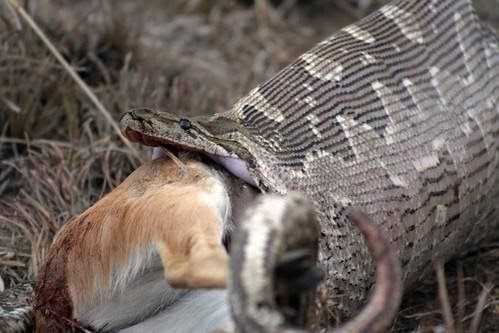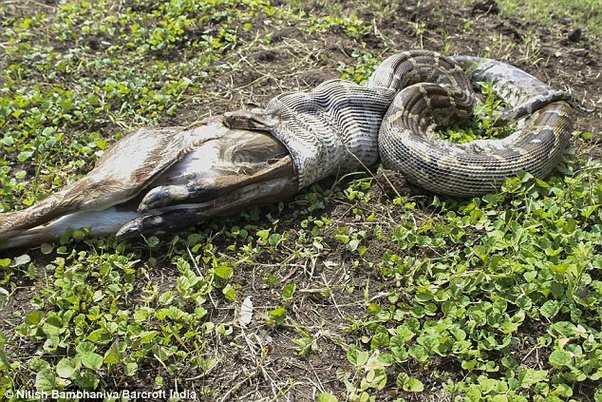
The snake devours its prey whole, its powerful jaws stretching to accommodate even the largest of meals. Once the snake has satisfied its hunger, a remarkable transformation takes place. The prey is now securely inside the snake’s body, and the process of digestion begins.
The level of digestion in a snake depends on various factors, including the size of the prey and the species of snake. Some snakes can take days or even weeks to fully digest their meals, while others complete the process much more quickly. Throughout this time, the snake may appear sluggish and less active, as it conserves energy for digestion.
The Digestion Process
After a snake has successfully caught and swallowed its prey, the digestion process begins. This is a crucial stage in the snake’s survival, as it takes time for the snake to break down and absorb the nutrients from its meal.
Once a snake has consumed its prey, it enters a state of repletion, where its stomach is full and satisfied. At this point, the snake’s body must work to digest and process the meal to extract the necessary nutrients.
Digestive System Adaptations
Snakes have a highly specialized digestive system that allows them to consume meals much larger than their own size. Their jaws are incredibly flexible, allowing them to open their mouths wide enough to engulf prey that is even larger than their own head. This is especially important for species that feed on larger animals, such as rodents or birds.
The Process of Digestion
Once in the stomach, the prey is broken down into smaller pieces through a combination of acid and muscular contractions. The nutrients from the prey are then absorbed into the snake’s bloodstream through the stomach lining.
The digestion process can take anywhere from a few days to several weeks, depending on the size and type of prey. During this time, the snake’s metabolism increases to accommodate the energy required for digestion.
Once the digestion process is complete, the snake will expel any indigestible parts, such as bones or fur, through its cloaca. It is then ready to resume its normal activities and potentially continue its quest for food.
When a snake catches its prey and consumes it, the process of digestion begins. This fascinating and unique process offers insight into the snake’s feeding habits and how it obtains the necessary nutrients for survival.
Once a snake has captured its prey, it will start by swallowing it whole. Snakes have the remarkable ability to stretch their jaws to accommodate prey items that are much larger than their head. This allows them to consume prey that may be the same size or even larger than their own body.
After the prey is swallowed, it enters the snake’s digestive system, where the real work begins. The snake’s digestive system is highly efficient and specifically adapted for processing large prey. The stomach of a snake can quickly expand to accommodate the meal, and this allows for the snake to feel satisfied and full after a large, gluttonous feeding episode.
The process of digestion in snakes is slow compared to other animals. This is because snakes are ectothermic, meaning they rely on external sources to regulate their body temperature. Because they don’t generate their own heat, snakes have a lower metabolic rate, which results in a slower digestion process.
During digestion, snakes may exhibit behaviors such as basking in the sun or finding warm areas to help raise their body temperature. This increased heat aids in the digestion process, as it helps to speed up the chemical reactions within the snake’s body.
Once digestion is complete, the snake will slowly slither away, often finding a safe and secluded spot to rest and recover. The repletion and digestion process can take several days to complete, depending on the size of the prey item.
| Benefits of Slow Digestion in Snakes | Drawbacks of Slow Digestion in Snakes |
|---|---|
| Allows efficient absorption of nutrients | Increased vulnerability to predators while digesting |
| Prolongs the feeling of fullness and satisfaction | Limited ability to hunt or defend during digestion |
| Conserves energy during the digestion process | Potential risk of regurgitating partially digested prey |
The Effects on the Snake’s Body
After ingesting a meal, a snake goes through a series of changes and adaptations to accommodate the large prey it has just consumed. These changes occur at both the physiological and behavioral levels.
Snake Behavior
Additionally, a snake will often seek out a safe hiding place after a meal. This behavior aligns with their instinctual need for protection during the vulnerable stage of digestion. They will find a secure hiding spot where they can rest undisturbed while their body works to break down and process the prey.
Physiological Changes

The snake’s digestive system also goes into overdrive during this time. The snake’s stomach produces strong digestive acids that break down the prey into smaller, more manageable pieces. Enzymes are also released to aid in the digestion process.
| Effects on the Snake’s Body | Description |
|---|---|
| Repletion | After a meal, a snake’s body is in a state of repletion, meaning it is completely full. The size of the meal can be significant in relation to the snake’s own body size. |
| Digestion | The digestion process can take several days to weeks, depending on the size of the prey. The snake’s digestive system works to break down the prey’s tissues and extract nutrients. |
| Gluttonous Behavior | Depending on the availability of prey, some snake species have been observed to exhibit gluttonous behavior, consuming multiple prey items in a short period. This behavior can have further effects on the snake’s body and digestion process. |
Overall, the effects on the snake’s body after eating are significant. The snake’s behavior becomes slower and more cautious, while its internal organs work diligently to digest and process the prey. A snake’s ability to adapt to these changes is crucial for its survival and ability to thrive in its environment.
Exploring the Physical Changes and Adaptations
When a snake consumes a large meal, its body goes through several physical changes and adaptations to accommodate the digestion process. One of the most noticeable changes is the snake’s distended abdomen, which becomes visibly bulged after a meal. This is because the prey is being digested inside the snake’s body, and the snake’s stomach expands to accommodate the food.
At a cellular level, the snake’s body undergoes a metabolic shift to facilitate digestion. After a meal, the snake’s metabolic rate increases, allowing for efficient breakdown and absorption of nutrients. This increased metabolic activity can last for several days, depending on the size of the prey and the snake’s species.
Overall, the physical changes and adaptations that occur in a snake’s body after consuming a meal are fascinating to observe. From the visible bulging of the abdomen to the metabolic shift and slow behavior, the snake’s body endures various transformations to ensure a successful digestion process. Once fully digested and satisfied, the snake is ready to continue its slithering journey in search of its next meal.
The Aftermath of a Meal
Once the prey is inside the snake’s body, the repletion level of the snake increases. The snake’s stomach starts to secrete powerful digestive enzymes that break down the prey’s tissues. This allows the snake to extract and absorb valuable nutrients from the prey.
During the digestion process, the snake’s body undergoes physical changes. The snake’s stomach expands to accommodate the prey, sometimes making the snake’s body appear distended. This is a necessary adaptation to accommodate the large meal. The snake’s metabolism also increases during digestion, as it needs to generate enough energy to break down and metabolize the prey.
Once the prey has been fully digested and absorbed, the snake’s repletion level decreases, and it will feel satisfied. At this point, the snake can resume its normal activities, such as slithering and hunting for its next meal.

I’m Lena Adams—a product of an unconventional upbringing in the African wilderness. My father, a daring explorer of African wildlife, sparked my fascination with reptiles, a passion that intertwined with the tragic loss of my mother during an expedition, leaving an indelible mark on my life. Driven to understand the creatures that captivated my parents, I embarked on my journey, sharing insights about reptiles, frogs, and lizards on my website. Through my explorations and conservation efforts, I honour my family’s legacy while seeking connections—to the creatures, nature, and the mother whose presence I yearn to understand.
